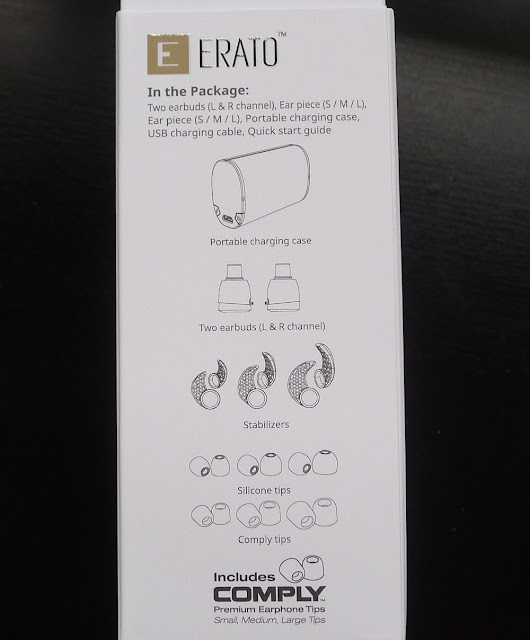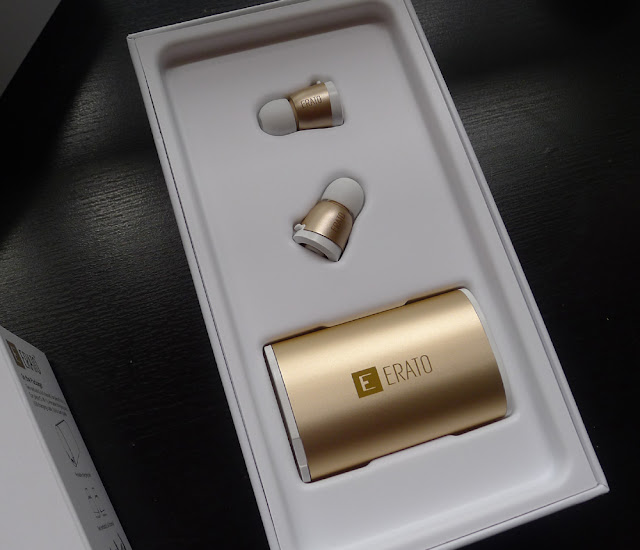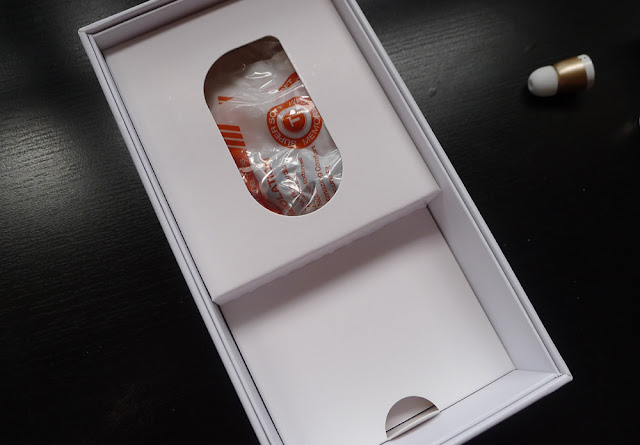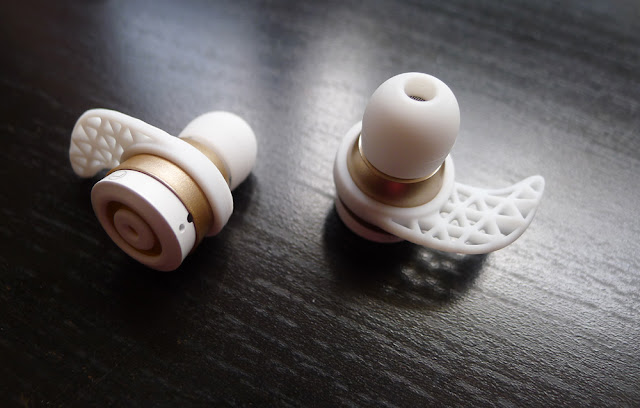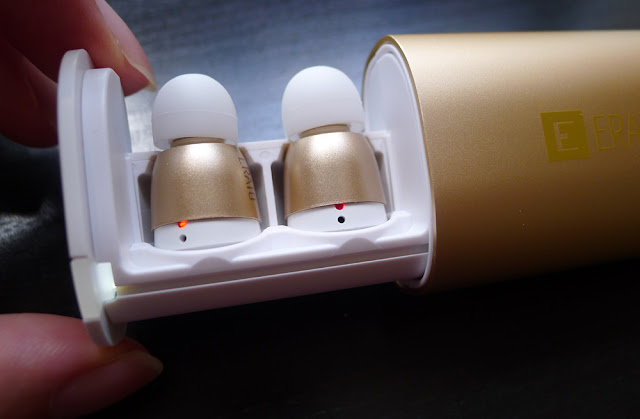Initiated as a Kickstarter project in 2015, California-based Erato Audio developed the Apollo 7 true wireless earbuds. Truly wireless earbuds are 2016's flavor of the year, even more so with iPhone 7's removal of the earphone jack. It's all the more timely that the Erato Apollo 7 (SGD 499 / USD 299) now hits the markets in Singapore with its most recent launch on 8 Oct. Oh, and it did scoop the 2015 Red Dot Honorable Mention Award on the way.
Unboxing
There are 4 colors available - Pink, Silver, Gray and Gold, of which we were provided the 4th variant.
Sliding out the outer layer reveals a solid white box. The side gives an idea what to expect in the packaging.
Pop the top lid open for the Apollo 7 earbuds and the charging case.
Lifting the bottom tab gives access the inner sanctum. Can't be too difficult to guess what lies beneath now, can it?
Spilling out the packaging contents reveals:
Design
The Apollo 7 buds are undeniably tiny. They each sport a single button and a circular contact point on the outer edge. Each Erato bud weighs an astonishing 4 grams, making these what they claim are the lightest truly wireless buds with an omnidirectional microphone. They compare favorably with the 3.5 gram Earin (without mic), the Samsung Gear IconX (6g) and Bragi Dash (7g).
The charging case allows the buds to be stored and charged simultaneously, similar to the Earin and Bragi Dash. There are 2 LEDs on the left side to indicate the charging status of the case from the micro-USB and of the earbuds respectively.
Features
Interestingly the Erato Apollo 7 has no app support and this breaks the trend of all the truly wireless buds we've looked at so far. While we check out the features and performance, we'll also assess whether the buds can hold up purely by hardware and firmware capability.
Breaking down the features:
1. Playback controls
There is a single button on each earbud and each side actually operates a different function. Here's how it works:
2. Waterproofing
There is a nano-coating which supposedly provides a layer of waterproofing (not submerging we might add). Let's just say that throwing some water on the buds didn't affect its functional duties.
3. Bluetooth (4.1)
Let's start with the basics - usage. I held the right earbud button to power on, did the same for the left bud and presto, both sides were connected. Holding the either button will initiate pairing with your music device. Out of the truly wireless earbuds tested, the Erato gives an added level of control due to the physical button. Other earbuds are only able to initiate pairing by parking / removing the buds from the charging case.
4. Notifications
The sound / voice notifications are kept to a minimal, all the more surprising given there's no mobile app. However, voice prompts informing that power is on and pairing is in progress is welcome. With a button on each bud for actuating, there's no further sound prompts when playing or skipping tracks.
Performance
As usual, we'll do some tests on the sound quality, noise isolation and whether there are any sound drop offs. Stay tuned!
For starters, do read our article on the different types of Comply Foam and their effectiveness.
Update (Feb 2017)
The Apollo 7 uses micro-sized dynamic drivers. The result is that the sound quality has good bass emphasis while the higher frequencies were quite clear. This is excellent for R&B or EDM tracks. This sound profile can be tweaked since you have both silicon and Comply Foam tips. Comply tips tend to reduce the treble and increase the bass. Personally, I favoured using the Comply tips.
Noise isolation using the silicon tips is decent but if this is a priority to you, do use the Comply Foam instead. Sounds on the bus or train can be blocked significantly and you are able to listen to your music quite peacefully.
Overall
The Erato Apollo 7 is a rare breed of true wireless earphones that is able to function without app support. That said, it's clear that playback controls can be adjusted from the buds directly. Apart from the general aesthetic where the buds protrude from your ears, it's a good all round pair of true wireless buds.
Where To Buy
If you like what you have read, feel free to support me by buying from Amazon (USD 299) or Lazada SG (SGD 499).
Credit to Erato and TC Acoustic for a review unit.
Unboxing
There are 4 colors available - Pink, Silver, Gray and Gold, of which we were provided the 4th variant.
 |
| Credit - Erato |
Sliding out the outer layer reveals a solid white box. The side gives an idea what to expect in the packaging.
Pop the top lid open for the Apollo 7 earbuds and the charging case.
Lifting the bottom tab gives access the inner sanctum. Can't be too difficult to guess what lies beneath now, can it?
Spilling out the packaging contents reveals:
- Erato Apollo 7 true wireless earbuds
- Charging capsule
- Silicon tips (S /M /L)
- Comply Foam Isolation tips (T-600) (S /M /L)
- Stabilizers (aka fins) (S/ M /L)
- Charging cable
- Quick Start Guide
- User Manual
Design
The charging case allows the buds to be stored and charged simultaneously, similar to the Earin and Bragi Dash. There are 2 LEDs on the left side to indicate the charging status of the case from the micro-USB and of the earbuds respectively.
Features
Interestingly the Erato Apollo 7 has no app support and this breaks the trend of all the truly wireless buds we've looked at so far. While we check out the features and performance, we'll also assess whether the buds can hold up purely by hardware and firmware capability.
Breaking down the features:
1. Playback controls
There is a single button on each earbud and each side actually operates a different function. Here's how it works:
- Hold - Power on
- Longer hold - Pairing initiates
- Single press - Play / Pause
- Double press (right bud) - Volume up
- Hold (right bud) - Next track
- Double press (left bud) - Volume down
- Hold (left bud) - Previous track
There is a nano-coating which supposedly provides a layer of waterproofing (not submerging we might add). Let's just say that throwing some water on the buds didn't affect its functional duties.
3. Bluetooth (4.1)
Let's start with the basics - usage. I held the right earbud button to power on, did the same for the left bud and presto, both sides were connected. Holding the either button will initiate pairing with your music device. Out of the truly wireless earbuds tested, the Erato gives an added level of control due to the physical button. Other earbuds are only able to initiate pairing by parking / removing the buds from the charging case.
4. Notifications
The sound / voice notifications are kept to a minimal, all the more surprising given there's no mobile app. However, voice prompts informing that power is on and pairing is in progress is welcome. With a button on each bud for actuating, there's no further sound prompts when playing or skipping tracks.
Performance
As usual, we'll do some tests on the sound quality, noise isolation and whether there are any sound drop offs. Stay tuned!
For starters, do read our article on the different types of Comply Foam and their effectiveness.
Update (Feb 2017)
The Apollo 7 uses micro-sized dynamic drivers. The result is that the sound quality has good bass emphasis while the higher frequencies were quite clear. This is excellent for R&B or EDM tracks. This sound profile can be tweaked since you have both silicon and Comply Foam tips. Comply tips tend to reduce the treble and increase the bass. Personally, I favoured using the Comply tips.
Noise isolation using the silicon tips is decent but if this is a priority to you, do use the Comply Foam instead. Sounds on the bus or train can be blocked significantly and you are able to listen to your music quite peacefully.
Overall
The Erato Apollo 7 is a rare breed of true wireless earphones that is able to function without app support. That said, it's clear that playback controls can be adjusted from the buds directly. Apart from the general aesthetic where the buds protrude from your ears, it's a good all round pair of true wireless buds.
Where To Buy
If you like what you have read, feel free to support me by buying from Amazon (USD 299) or Lazada SG (SGD 499).
Credit to Erato and TC Acoustic for a review unit.


